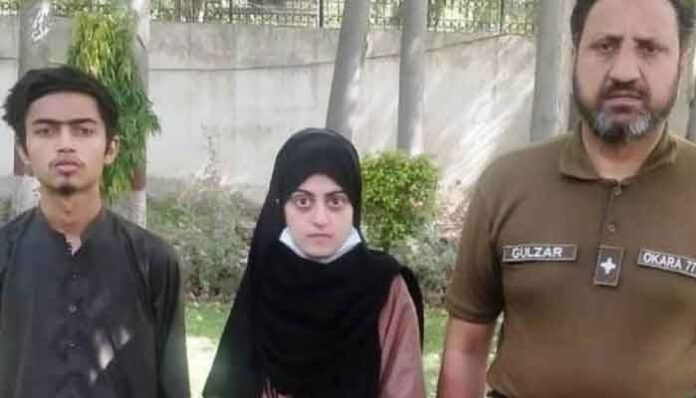LAHORE: The year 2021 ended on a sour note for the vulnerable female youth of Pakistan, as numerous cases of missing girls surfaced. The year ended, but not such cases which continue to haunt helpless parents, vulnerable teens and their unabated misery.
The question of women protection still remains unresolved in Pakistan, as women, especially girls in their teens struggle for their rights, respect and identity which has become an uphill battle for them.
However, the continued denial of the girls’ rights by the society, the government and the judicial system continues unabated. Kidnapping of teenagers, forced marriages and possibility of human trafficking have aggravated the situation.
Perhaps, just like previous governments, the current Pakistani administration believes they are doing enough but the truth is the opposite. Today, the abduction, forced child marriages that may result in human trafficking of young Pakistani girls have become one of the biggest human rights crises of the era. Another issue remains unattended is the excessive exposure of young kids, especially the girls, to the internet which is a major source of teen girls being lured into relationship and fake promises.
Earlier, on 26th November 2021, the All-Party Parliamentary Group (APPG) published a report which highlighted the practice of forced marriages which amplified steadily in recent years that hints at the calamitous handling of the government to reinforce much-needed legislation to curb this inhuman crime.
Similarly, the government has failed to implement the Child Marriage Restraint Act 1929 and the Sindh Child Marriage Restraint Act 2013, which raised the legal minimum age of marriage to 18 in Sindh province. Regrettably, these laws have not been implemented properly in Sindh and other provinces of Pakistan.
The victim girls are largely left in the custody of their kidnapper throughout the trial process, where they are forced to claim that the marriage was consensual. A similar practice has been witnessed in the Dua Zehra case which has grabbed the attention nationwide. Dua Zehra who is an underage girl (which her parents claim through NADRA registered documents), who went missing from her house in Karachi.
After hectic efforts of Police, the girl finally appeared in Sindh High Court along with her spouse and claimed that she is 18 years old and also made a statement that she had married the young man of free-will. The case got media hype as her father approached higher ups. Following that, the girl was probably forced to give a confessional statement so that the family stops proceeding with the case. However, her parents remain adamant in their struggle for justice.
During today’s hearing in the SHC, Dua recorded her statement before the court, claiming that she was 18 years old. “I was not kidnapped. I married Zaheer of my free will and want to live with him,” she said.
The Sindh Advocate General argued that “the girl has said that she went off her free will,” while reiterating that “no crime” occurred in Sindh and that the marriage was contracted in Punjab.
Here, Justice Ghaffar remarked: “This means that the petition regarding her recovery has now become redundant.
“The girl is standing in front of us and is saying that no one abducted her,” he added, and subsequently ordered that Dua be sent to a shelter home.
Dua further refused to meet her parents despite their pleas. The court believes her statement, and declares the couple as husband and wife, while giving a ruling that ‘no crime has taken place in Sindh’, which means that whatever happened in Punjab is irrelevant at this point. Following the ruling, the girl was sent to a shelter home in Karachi.
The court’s controversial ruling has raised many questions. What if Dua Zehra was actually kidnapped? Wouldn’t the court’s ruling give an easy escape to the offenders by committing a crime in one province and fleeing to another to avoid accountability. Also, in the very first hearing of this case, why didn’t the court order for her medical right away? The court sent her off with her husband without confirming her age, which was one of the prime examples of the loopholes in our judiciary system.
Why do our courts and judges fail to realize the severity of such issues? Why is it so difficult for our law to comprehend that it is extremely easy and common in Pakistan to blackmail and pressurize a victim to give statements in favor of the offenders in courts?
A similar case caught media’s attention later in 2021, where a 13 year old Christian girl Arzoo Raja was abducted and forced into marriage by a 44 year old offender in Karachi. However, when Arzoo was recovered and presented in court, she gave the exact same statement that Dua Zehra gave. She stated that she wasn’t kidnapped and had left with her offender Azhar voluntarily.
The offender’s lawyer kept on arguing that Azhar could not be arrested as they claim to be husband and wife. The police cannot acquire remand either for this reason, he claimed.
However, after the medical board confirmed that she was around 13 years of age, and it was not possible for her to enter into a legally valid marriage as her consent had no legal value, she was sent to a shelter home and her offender got arrested.
Soon afterwards, the girl moved an application with the SHC, seeking to return to her parents’ house. It is pertinent to note that until her offender was arrested, the girl kept on giving statements in her offenders’ favor, which proves that the statements were being given by minor girls under pressure and should hold no legal value.
Unfortunately, the judiciary is taking rather longer time to understand the real problem, which is causing huge damage to the country’s reputation. We are all familiar with the fact that this crisis is a product of the government’s failure over decades to protect females from abuses and victim blaming.
It is evident that Pakistan’s ineffective policy reforms to address forced marriages have exacerbated the situation. It is wholly illogical and disappointing that such marginal opportunities for legislative and policy reforms are flushed down by entrenched lines of incompetence and lack of seriousness. It is no surprise that such astonishingly oppressive measures have played a role in creating a pandemic of forced marriages.
Secondly, the police often turns a blind eye to reports of abduction, forced child marriages, and set up impunity for perpetrators by refusing to record a First Information Report (FIR) or falsifying the information. As a result, the victim girls are largely left in the custody of their kidnapper throughout the trial process, where they are subject to rape and forced to claim that the marriage was consensual.
Such earth-shattering events often implant a ticking time bomb in victims that may detonate repeatedly in their lives, in the form of emotional breakdown, self-harm or extreme anxiety. Yet, this seems important to shake off the police and rule of law which must safeguard the rights of vulnerable victims. Hence, the predators of such vicious crimes remain free at large from the reach of the government and its justice system to lure others to join a “mafia” that preys on teenage girls.
The part of the problem is also an ineffective justice system that is discriminatory, particularly towards women which means victims and their families are scared of pleading the case with the challenges to afford a lawyer, in many cases. However, in most cases, the production of marriage certificates is enough evidence to pardon the abductors. It is apparent that the system has loopholes and reform is necessary to protect both the human and legal rights of the victims.
Despite all calls to stop forced abductions and marriages from the human rights organizations, Pakistan’s government still demonstrates a marginal interest to advance the frameworks of policy and dialogue to ensure the safety of under age girls and women in general. Although the wind turbines of women rights have been spinning since the independence of Pakistan, when it comes to forced marriages of underage girls, we are going round and round in circles.























